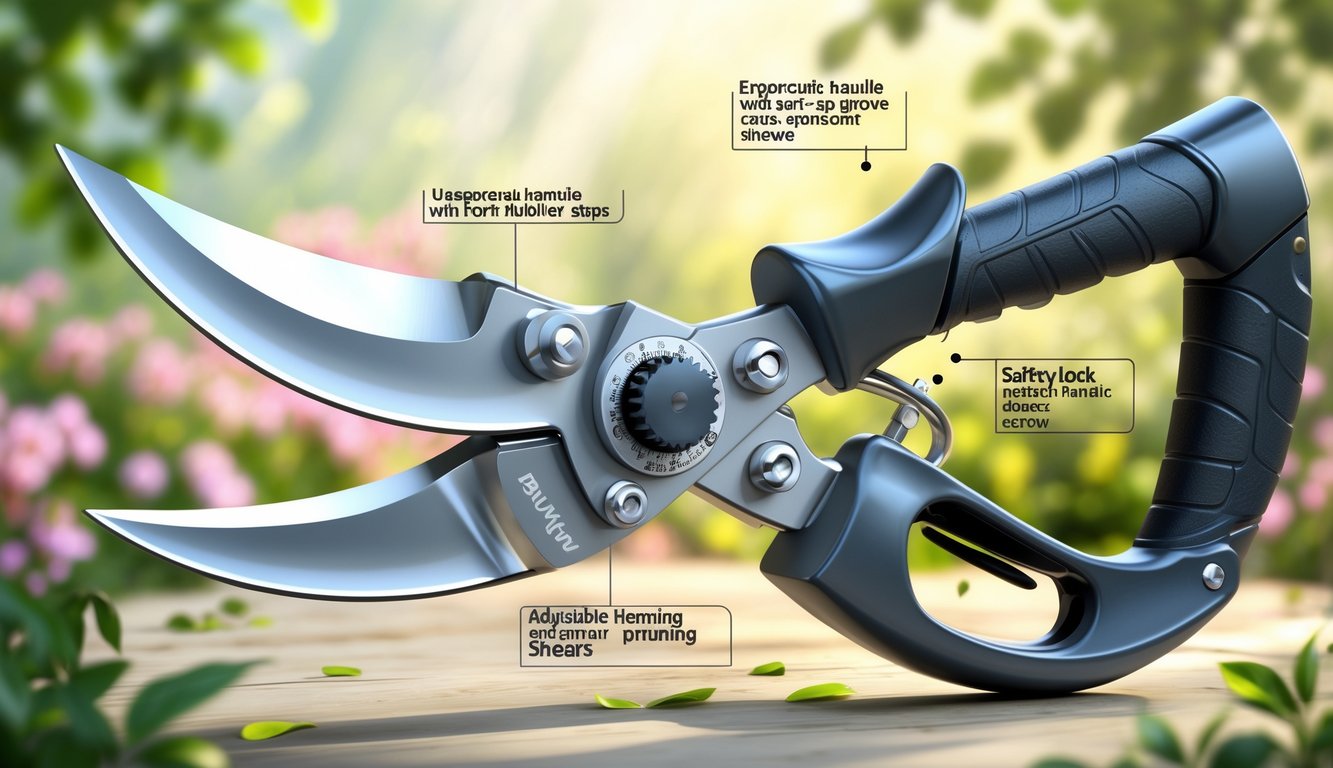
Serrated edges. Why don’t people talk about them? I’m out there, hands soaked, pruners slipping, stems looking like I chewed them, and nobody says, “Hey, get the ones with the little teeth.” Nope. I found out about sap grooves, springs you can swap, and locks that actually work only after I ruined a few plants and my mood. It’s wild—these things change everything, but does the box say a word? Of course not. My “best” pair? Total fluke. A grumpy ex-nursery manager at the garden center told me to check blade alignment and tension screws. “Saves your wrists,” she said. I rolled my eyes. Then, surprise, my wrist stopped screaming after a week.
What’s even weirder: people obsess over color or shiny blades. Why? Meanwhile, that tiny wire-cutting notch (pretty sure it’s on old Felcos?) or those goofy safety clips matter way more. I read this HGTV roundup—they barely mention spring-loaded handles. But when my shears lock up in a rose bush, I remember: little features decide if I’m swearing or actually enjoying myself.
Ever tried to cut dead wood with bargain pruners? You just mash the branch. Anvil-style isn’t a joke, but bypass is still king. Except nobody warns you: let the blades misalign, and suddenly you’re hacking instead of slicing. I saw “anti-rust coating” on a package yesterday. Shouldn’t that be standard? Every time I meet someone with old, battered pruners, they’ve got one weird feature they swear by. Kind of jealous, honestly.
What Makes Pruning Shears Unique Today?
Here’s what bugs me: every brand calls their handles “ergonomic” like it’s a magic spell. My wrist is supposed to feel amazing? Sure. Then I pick it up—awkward pressure, sticky hinge, handle so long I feel like I’m fencing. Every “quality” shear ad flashes some wild blade or grip, but after a year in the dirt, only a couple even work right. Most are just hype.
Advancements in Blade Technology
Let’s get this out of the way: sharpening old bypass shears was my Saturday ritual. Sometimes twice if I got into sap-heavy branches. Now, there’s micro-serrated edges, fancy steel, and straight vs. curved blades. Suddenly, I’m snipping roses and the cut is actually clean. My neighbor’s shears? Absolute stem carnage.
Manufacturers keep bragging about carbon steel. Is it really that big of a deal? I’m convinced anti-rust coatings do half the work, especially when I forget to clean up. Ask any pro—they’ll rave about bypass pruners, dual-curved blades, “scissor action,” cleaner cuts. I mean, sure, but then why do my hands hurt after five minutes? Gil at the nursery swears by micro-tip snips for bonsai, but for marigolds? Feels like overkill. I just switch blades depending on what I’m hacking back. “All-purpose” is a myth.
Innovative Handle Designs
Soft grips, anti-slip, all that—don’t believe the hype. I’ve tried eight pairs, and half made my pinky go numb. Ratchet handles? Great in theory. Ever seen someone forget to unlock it? It’s like wrestling a jar lid. Electric pruners—yes, that exists now. My friend’s model buzzed like a dentist’s drill and hid the safety under the handle. Super safe. Supposedly, pros love them, but if I lose another charger I’ll scream. I’m sticking with manual for now.
Looped handles give leverage, but with gloves? Not happening. Offset grips, rotating pivots, cushioned bumpers—they all promise miracles. On a hot day, I just want a grip that doesn’t slip and that I can rinse off. I don’t think anyone designing these things has ever gardened in Texas. Sap will defeat every “premium” handle, guaranteed.
Unexpected Features Gardeners Overlook
This week alone, I watched five people ruin gloves or get stuck with sticky blades. It’s stuff nobody tells you—little features you don’t notice unless you’re bored enough to stare at your tools. I’ve got receipts: the “big name” means nothing if your hands are covered in sap and the grip is slick.
Hidden Sap Grooves For Cleaner Cuts
Sap grooves are sneaky. That sticky layer slows you down, but nobody points out the tiny channels on some blades. Factory reps at the garden expo mumbled about them—apparently, they drain sap off so you don’t gum everything up. I used Felco F8s for months and didn’t see the groove until someone poked it with a stick. It makes a difference. Hedge shears? No groove. Enjoy scraping resin for hours. HGTV says sap grooves help avoid downtime. Not every pruner has them, especially the cheap ones. More mess, more regret.
Integrated Wire Cutting Slots
Cutting wire with old pruners? Don’t. You’ll destroy the blade and end up searching for wire cutters anyway. When I found pruners with a wire slot (usually a notch near the blade base), I laughed. Who thought of this? But it’s genius. Felco F2 Classics have it. You cut support wire, twist ties, whatever, and keep your blade sharp for plants. The Strategist calls this a must-have. If you don’t have it, you’ll dull the blade and blame the tool. Been there. Not anymore.
Replaceable Blade Systems
Confession: I used to toss old shears the second they dulled. Replacement blades seemed like a hassle. Then I watched a guy swap his Felco blade in a parking lot—took maybe a minute. High-end pruners like Felco, Berger, Gonicc, they let you keep the handle and just swap blades. It’s not even expensive. Two Green Leaves points out these last way longer. Some gardeners avoid them—maybe the tiny screw scares them? Or they just don’t know. My advice: don’t toss a good handle just because the blade’s toast.